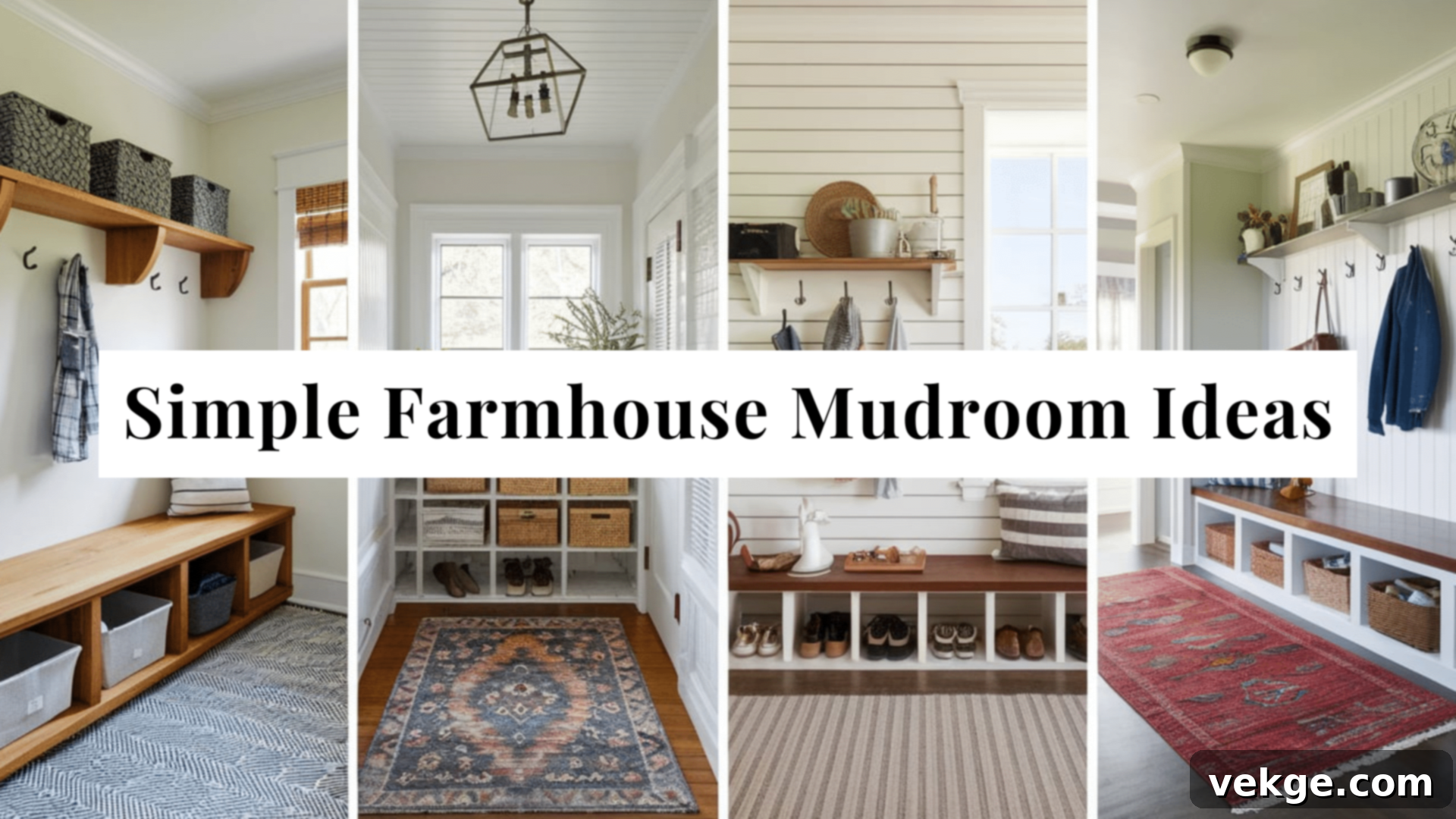Farmhouse Mudroom Ideas: Create a Stylish & Functional Entryway for Your Home
A farmhouse mudroom is more than just a passing trend; it’s a perfect blend of style and practicality, offering a dedicated space where you can shed coats, kick off shoes, and drop bags before entering the main living areas. This essential buffer zone helps maintain cleanliness and organization throughout your home, preventing dirt and clutter from spreading.
With its inherent cozy and rustic charm, a farmhouse mudroom instantly adds character and warmth to your home’s entryway. This guide will walk you through simple, creative, and budget-friendly farmhouse mudroom ideas that can be adapted to any space, regardless of its size. Whether you’re planning to install custom shelving, practical hooks, a comfortable bench for seating, or simply adding decorative accents, there are countless ways to make this area both functional and beautifully inviting.
The best part is that you don’t need an enormous budget to achieve a stylish and efficient mudroom. With a few smart, cost-effective touches, a dash of creativity, and a clear vision, you can design a farmhouse mudroom that perfectly suits the needs and aesthetics of your family. Let’s explore how to bring these inspiring ideas to life!
What is a Mudroom and Why Do You Need One?
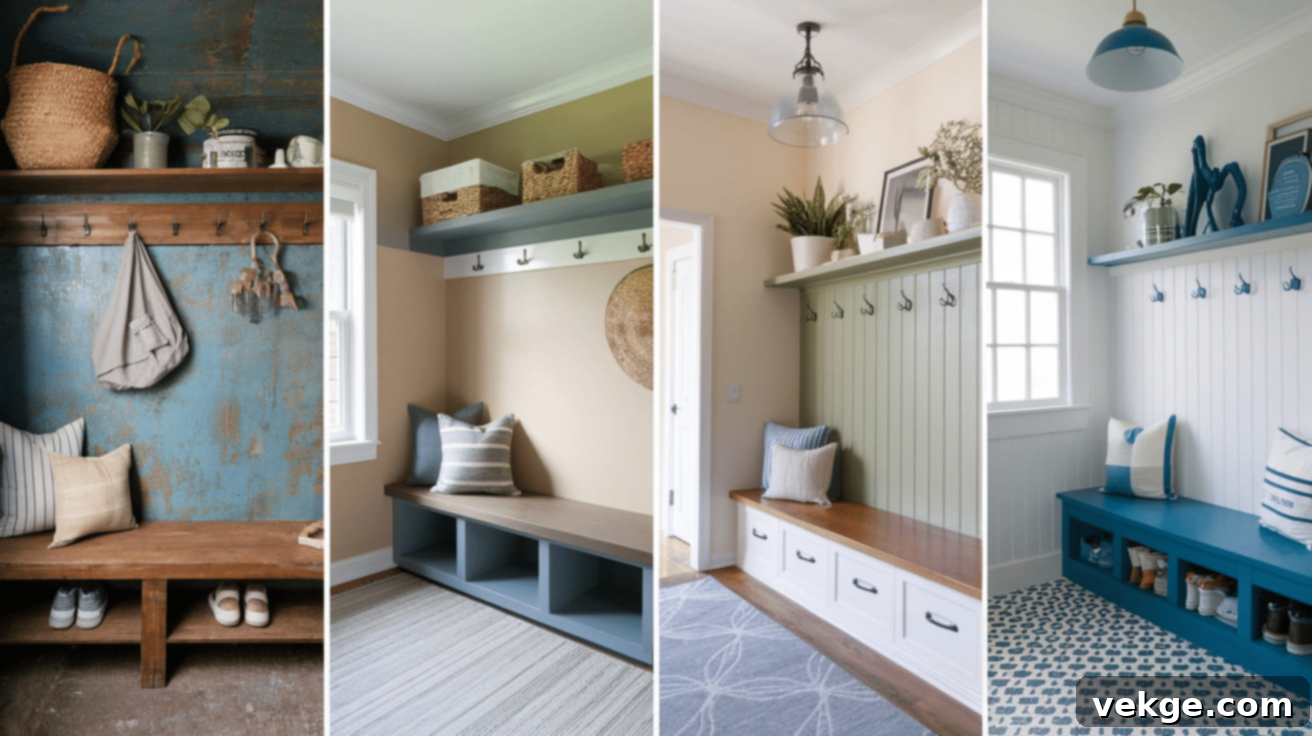
At its core, a mudroom is a transitional area typically located near an entrance to your home, often connected to a garage, back door, or main entryway. Its primary purpose is to serve as a designated drop-off point for outdoor items like shoes, coats, backpacks, and sports equipment before you fully step into your clean living spaces. Think of it as a practical buffer zone designed to contain dirt, mud, and general clutter, preventing them from being tracked throughout your house.
A well-designed mudroom often features a combination of storage solutions. You might find sturdy hooks for hanging coats and bags, individual cubbies or baskets for storing shoes and accessories, and perhaps a comfortable bench for sitting down to put on or take off footwear. This thoughtful arrangement helps keep everything organized and easily accessible.
Mudrooms are incredibly beneficial for maintaining a tidy and stress-free home. Here’s an in-depth look at why every home can benefit from having one:
- 1. Keeps Dirt Outside: This is arguably the most significant benefit. A mudroom acts as a containment zone for dirt, mud, snow, and rain. Instead of tracking these elements through your hallways and into your carpets, they are contained within this easy-to-clean area. This saves you significant time and effort on daily cleaning.
- 2. Organizes Your Stuff: Tired of coats draped over chairs and shoes scattered by the front door? A mudroom provides a central, dedicated place for all your family’s outdoor essentials. Hooks, cubbies, shelves, and baskets ensure that coats, bags, hats, scarves, and gloves each have a designated home, reducing visual clutter in other parts of your house.
- 3. Provides Extra Storage: Beyond daily essentials, a mudroom is an excellent spot for storing bulkier outdoor gear that might otherwise clutter closets or garages. This could include umbrellas, dog leashes, backpacks, sports equipment, gardening tools, or even seasonal items like winter boots or beach towels. Vertical storage solutions can maximize even small spaces.
- 4. Makes Coming and Going Easier: Streamline your daily routines with a mudroom. When heading out, you can quickly grab your coat, keys, and bag from one convenient location. Upon returning, you can effortlessly shed your outdoor layers, making the transition into home life smoother and more organized, especially for busy families.
- 5. Enhances Home Value & Appeal: A well-designed mudroom, especially one with a charming farmhouse aesthetic, can significantly increase your home’s functionality and curb appeal. Potential buyers often appreciate dedicated storage and organized spaces, recognizing the practical benefits it brings to daily living.
In essence, having a mudroom helps your home stay neat, clean, and functional. It’s a versatile space that adds both practical utility and undeniable style to your entryway, making daily life just a little bit easier and a lot more organized.
Features of a Farmhouse Mudroom
A farmhouse mudroom is designed to be a highly practical and aesthetically pleasing space, ensuring your home remains organized and clean while exuding a welcoming, rustic charm. It integrates several key features that make it both highly functional and delightfully cozy. Here’s what you’ll want to incorporate when designing your own farmhouse-style mudroom:
- 1. Simple Rustic Design: The heart of a farmhouse mudroom lies in its rustic charm and unpretentious elegance. This style embraces natural elements like warm wood accents, often featuring distressed or reclaimed finishes. The color palette typically leans towards neutral tones such as whites, creams, grays, and soft blues or greens, creating a calm and airy atmosphere. Classic design elements, like shiplap walls or board-and-batten, are frequently used to evoke a sense of heritage and simplicity. The overall goal is to create a welcoming, easy-to-maintain space that feels inherently cozy and timeless, just like a traditional farmhouse.
- 2. Smart Storage Solutions: Effective organization is paramount in any mudroom. Farmhouse mudrooms excel in offering a variety of smart storage options that are both practical and beautiful:
- Hooks: Essential for hanging coats, jackets, hats, scarves, and even dog leashes. Opt for vintage-style, wrought iron, or chunky wooden hooks for an authentic farmhouse look. Consider double hooks for extra capacity.
- Shelves or Cubbies: Perfect for storing shoes, bags, baskets, or decorative items. Open shelving can keep the space feeling light and airy, while cubbies provide individual compartments for each family member’s belongings, promoting order.
- Baskets: A farmhouse staple, baskets (wicker, wire, or galvanized metal) are excellent for corralling smaller items like gloves, scarves, umbrellas, school supplies, or even pet toys. They add texture and hide clutter beautifully.
- Built-in Cabinetry: For larger spaces, custom built-in cabinets can offer seamless storage, hiding bulkier items behind closed doors for a streamlined look.
- 3. Comfortable Seating: A bench or a small chair is an absolute must-have in a farmhouse mudroom. It provides a convenient and comfortable spot to sit down while you put on or take off shoes and boots, especially important for children or those with mobility challenges. You can enhance comfort and style by adding a soft cushion, throw pillows, or a chunky knitted blanket, which also contribute to the cozy farmhouse aesthetic. A bench with hidden storage underneath is an added bonus, maximizing functionality.
- 4. Durable Materials: Mudrooms endure a lot of wear and tear due to high foot traffic, dirt, and moisture. Therefore, choosing tough, easy-to-clean materials is crucial for longevity and practicality. Look for:
- Wood: Ideal for shelving, benches, and hooks. Reclaimed wood or distressed finishes not only look authentic but also hide minor scuffs and wear effectively.
- Tile or Vinyl Flooring: Porcelain or ceramic tiles are incredibly durable, water-resistant, and easy to wipe down. Vinyl plank flooring offers a similar aesthetic with excellent water resistance and a softer feel underfoot, making both perfect for muddy boots and wet paws.
- Metal Accents: Galvanized metal, wrought iron, or brushed nickel can be used for hooks, baskets, or light fixtures, adding an industrial-farmhouse touch that is both durable and stylish.
- 5. Ample Lighting (Natural & Artificial): Farmhouse interiors often celebrate natural light. If your mudroom boasts large windows or a glass-paned door, make the most of it. If natural light is limited, use light-colored paints on walls and ceilings to brighten the space. Strategically placed mirrors can also reflect light, making the room feel larger and airier. Supplement natural light with charming artificial lighting fixtures like vintage-style pendant lights, barn lights, or wall sconces to ensure the space is well-lit and inviting even on cloudy days or evenings.
- 6. Thoughtful Farmhouse Decor Touches: To truly infuse your mudroom with personality and warmth, add small, carefully chosen farmhouse-style decor elements. These personal touches transform a functional space into a cozy extension of your home:
- Vintage Signs or Artwork: Inspirational quotes, botanical prints, or rustic signs.
- Textiles: Plaid or striped throw pillows, knitted blankets on the bench.
- Greenery: A few indoor plants in galvanized pots or terracotta planters bring life and freshness.
- Functional Decor: Antique watering cans, woven baskets, or ceramic jars can serve as both storage and decorative elements.
These features work in harmony to create a farmhouse mudroom that is not only highly practical for daily use but also incredibly stylish and welcoming. Whether you have a generous space to work with or are transforming a small corner, these ideas will guide you in designing a mudroom that perfectly fits your family’s needs and captures that coveted farmhouse aesthetic.
Creative & Budget-Friendly Farmhouse Mudroom Design Ideas
Creating your dream farmhouse mudroom doesn’t have to be an expensive or complicated endeavor. With a blend of simple, thoughtful touches and some creative, DIY-friendly thinking, you can design a stylish, functional, and inviting space that perfectly fits your family’s needs and respects your budget. Get inspired by these innovative ideas!
1. Shiplap Walls
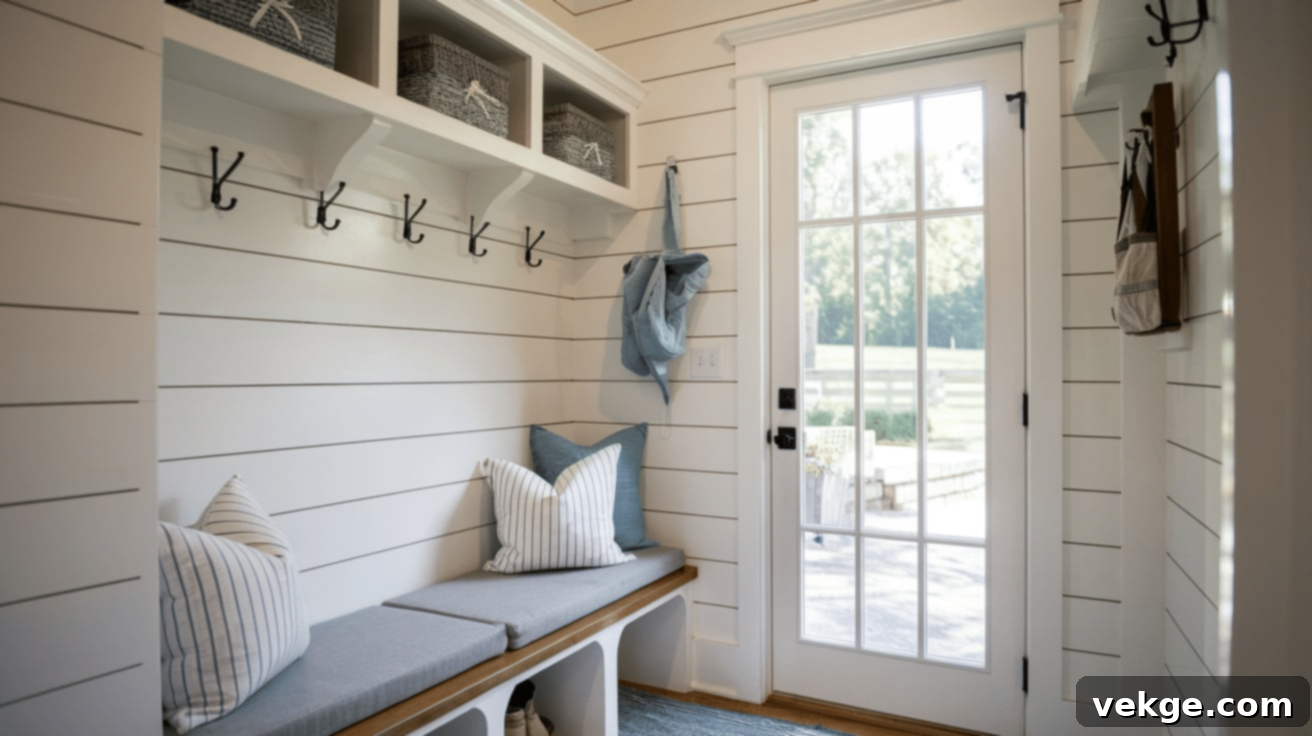
Shiplap is a quintessential farmhouse feature, instantly recognizable for its clean lines and rustic charm. Installing shiplap on your mudroom walls, or even on a focal wall or the ceiling, can dramatically transform the space, imbuing it with a cozy and inviting atmosphere. It adds a subtle yet impactful texture and warmth, grounding the room and making it feel authentically farmhouse. You can opt for traditional white shiplap for a bright, airy feel, or a distressed wood finish for a more rugged look. It’s a relatively straightforward DIY project that makes a huge difference.
2. Vintage Hooks
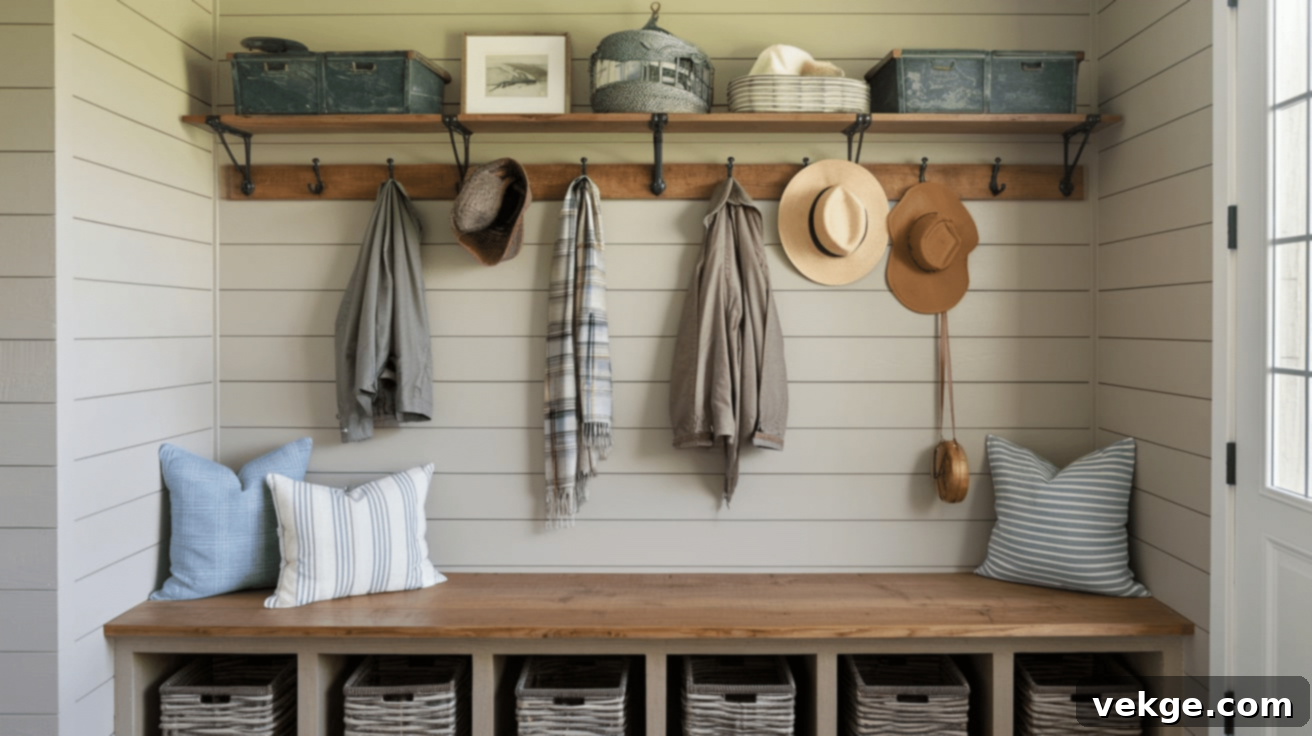
Beyond their practical function, old-fashioned hooks are a stylish detail that adds character to your mudroom. Use them generously to hang coats, bags, scarves, hats, and even umbrellas. Don’t be afraid to mix and match different styles, sizes, or finishes of hooks—think cast iron, brass, or distressed wood—to create a unique, curated look. Vintage or industrial-style hooks, readily available at antique shops or online, will provide that perfect, authentic farmhouse touch and stand up to daily use.
3. Sturdy Wooden Benches
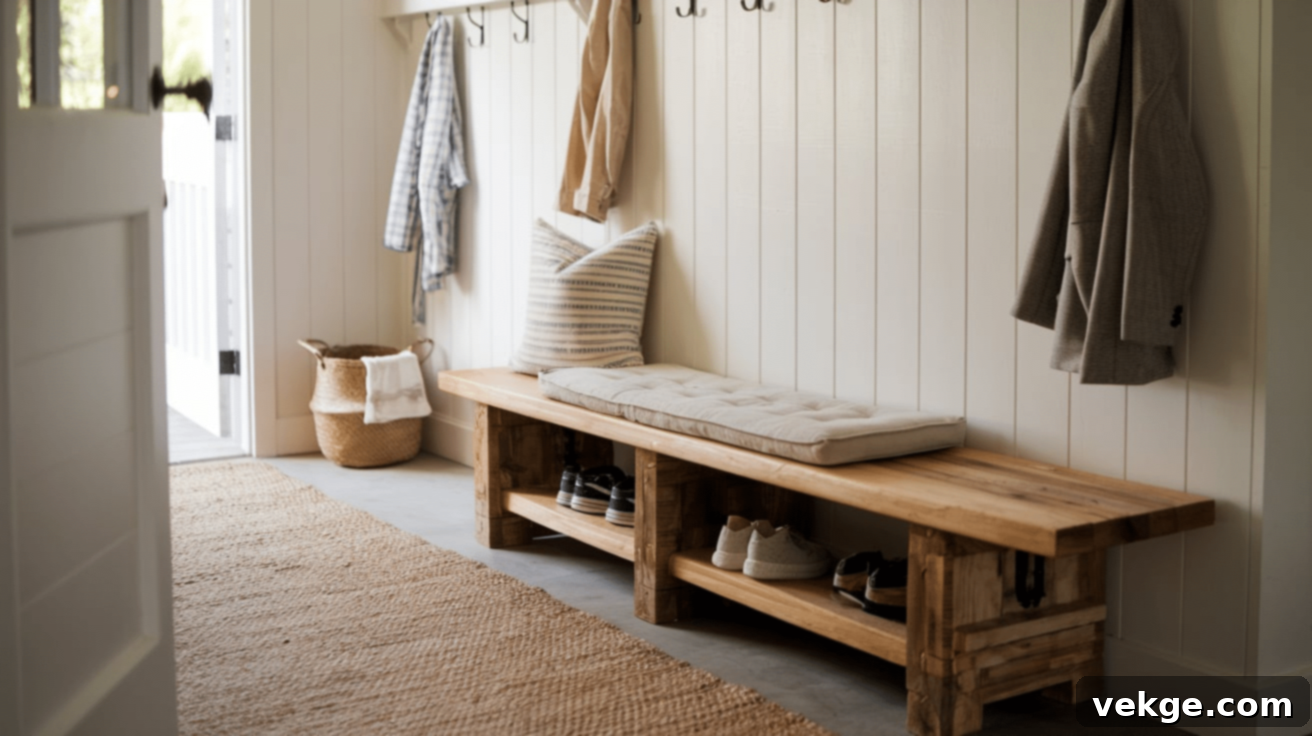
A sturdy wooden bench is an absolutely essential feature in a farmhouse mudroom. It provides a comfortable and convenient spot for family members and guests to sit down while taking off or putting on shoes and boots. Whether you opt for a simple, solid wood bench, a built-in bench with integrated cubbies or drawers for extra storage, or a salvaged antique piece, it will instantly add both crucial functionality and rustic charm to your space. Consider adding a cozy cushion or throw blankets to enhance comfort and visual appeal.
4. Open Shelving
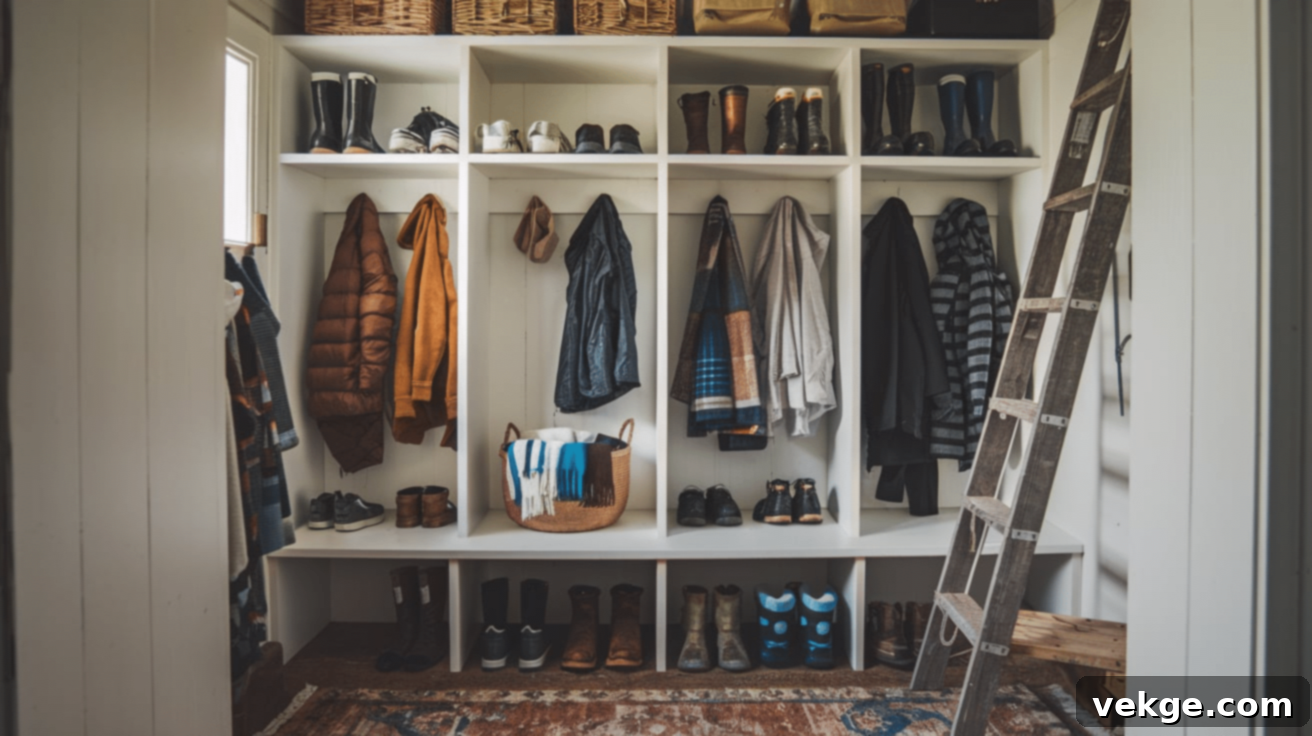
Open shelving is a fantastic addition that brings both functional storage and an airy feel to your mudroom. You can use these shelves to display decorative baskets filled with smaller items, neatly stack shoes, or store grab-and-go bags, keeping everything easily accessible. This storage style helps your mudroom feel organized and spacious, preventing the closed-off feeling that can sometimes come with too many cabinets. Reclaimed wood shelves or simple painted planks supported by industrial-style brackets will look perfectly at home in a farmhouse setting.
5. Classic Farmhouse Sink
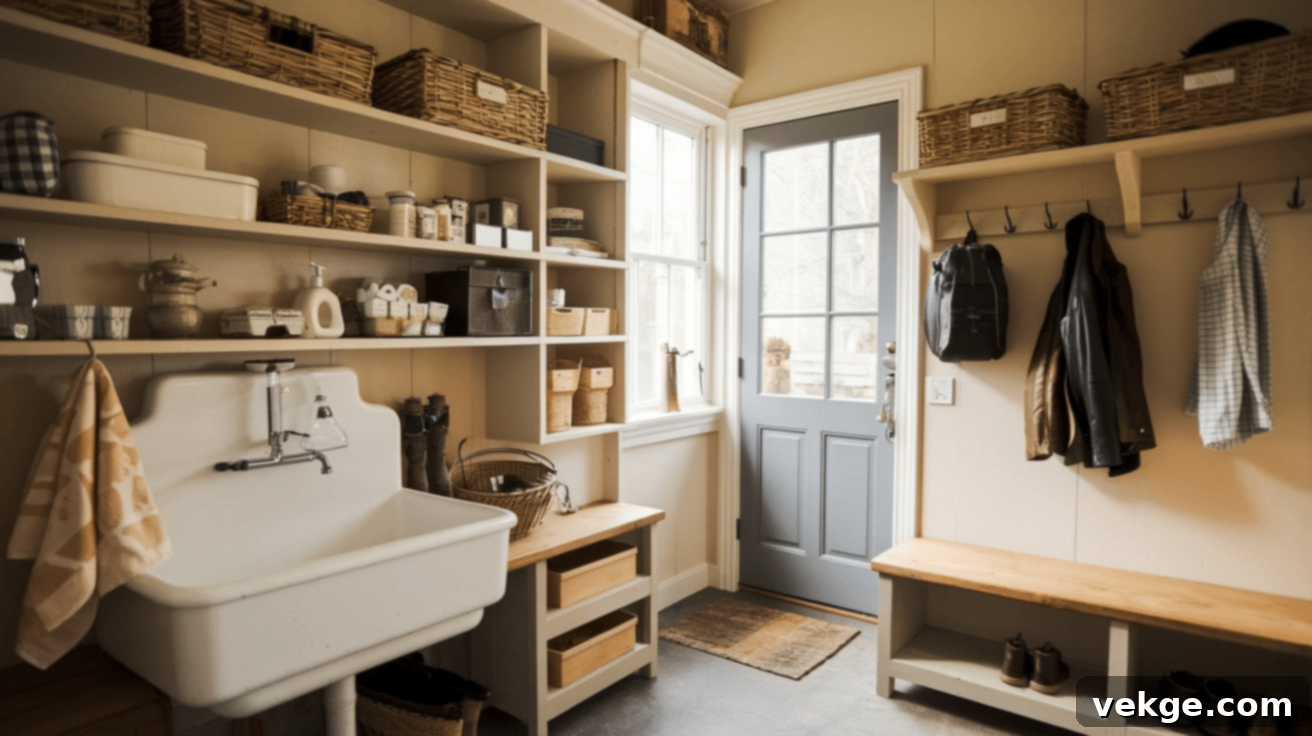
If your mudroom has enough space to incorporate a utility area, a classic farmhouse sink is a dream addition. It’s incredibly practical for washing off muddy boots, rinsing dirty gardening tools, cleaning hands after outdoor activities, or even pre-soaking soiled clothes. The characteristic large, deep basin offers plenty of room for all sorts of cleaning tasks, and its timeless design instantly enhances the authentic farmhouse look of the space. Pair it with a vintage-style faucet for extra charm.
6. Sliding Barn Door
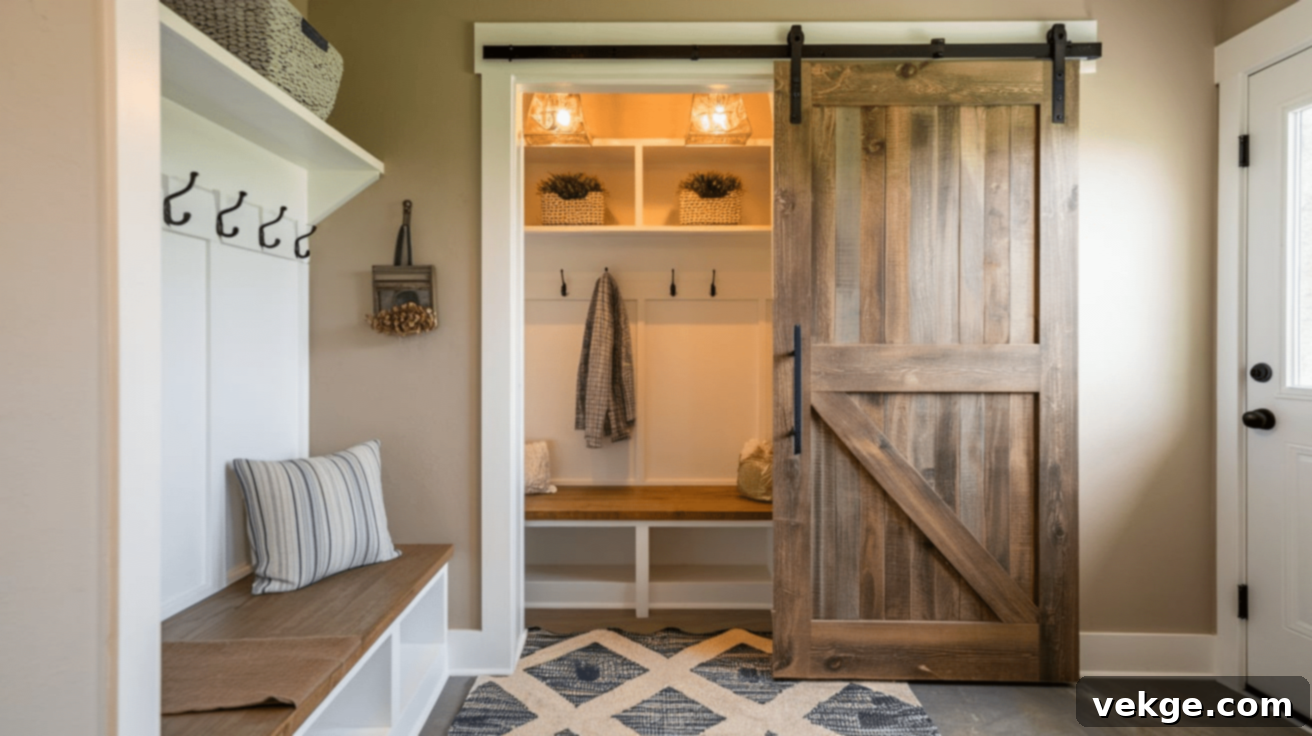
A sliding barn door is not only a stylish design element but also a clever space-saving solution, especially in smaller mudrooms where a traditional swinging door might be impractical. You can use it to beautifully separate your mudroom from the rest of the house, or to discreetly conceal a laundry area or storage closet within the mudroom itself. The prominent hardware and rustic wood of a barn door instantly add that defining rustic touch and architectural interest that epitomizes farmhouse style.
7. Rustic Lighting Fixtures
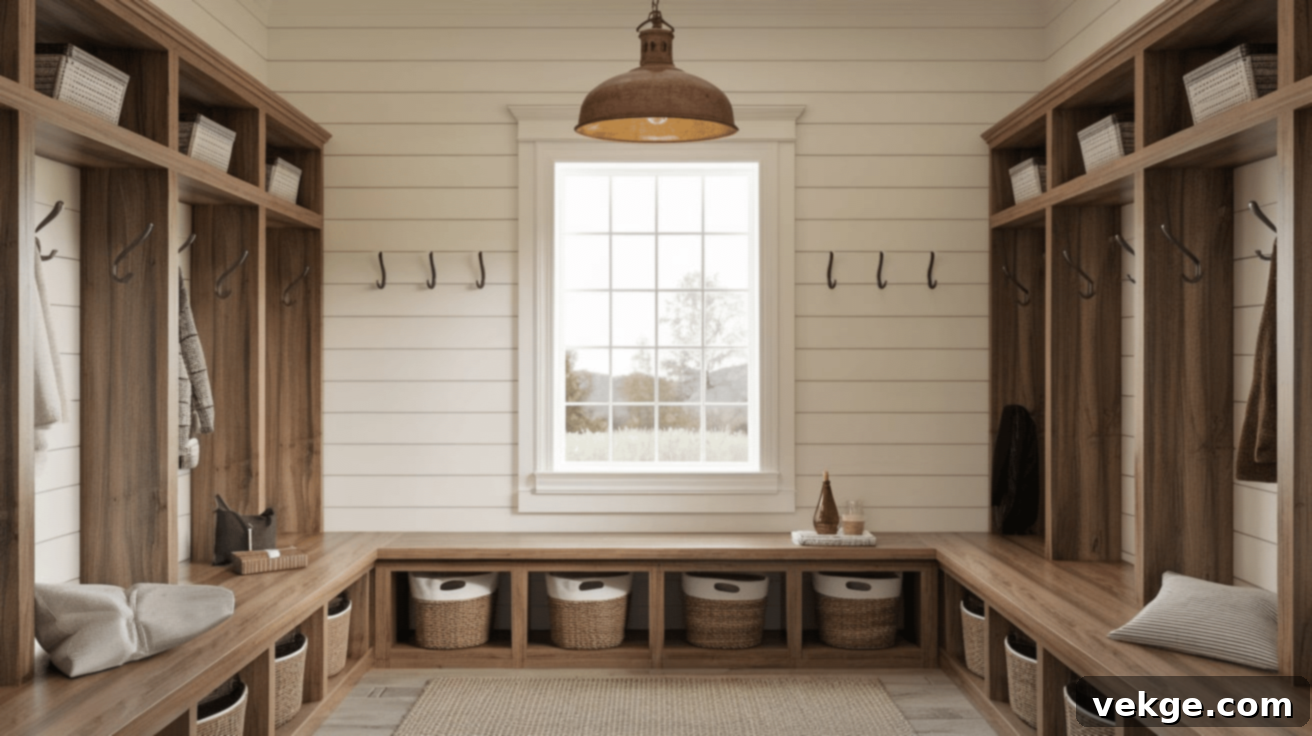
Proper lighting is crucial for both functionality and creating a warm, welcoming ambiance in your farmhouse mudroom. Opt for vintage-style light fixtures that complement the rustic aesthetic, such as metal pendant lights, classic barn lights, lantern-style fixtures, or industrial-inspired sconces. These types of lighting elements provide essential illumination while simultaneously acting as charming decorative features, ensuring the room feels cozy and inviting the moment you step inside.
8. Abundant Basket Storage
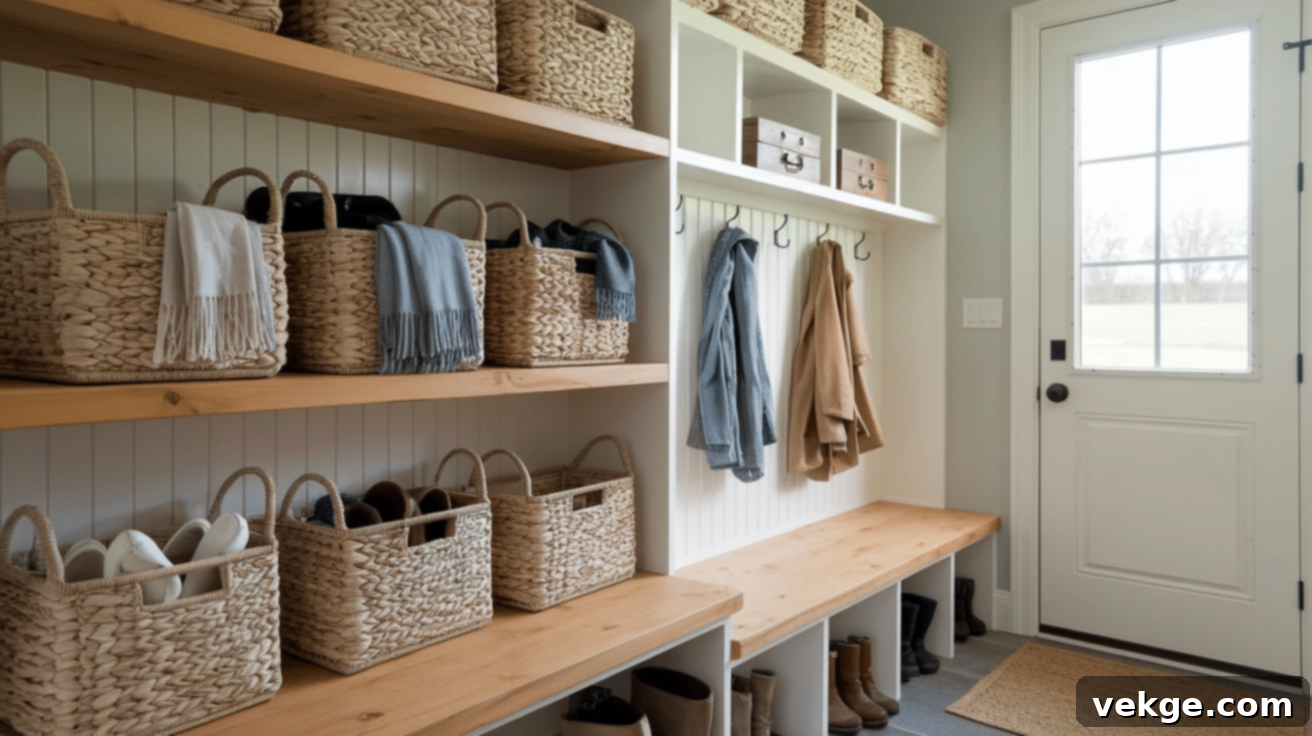
Baskets are an absolute must-have for any functional mudroom, offering a stylish way to contain clutter. They are perfect for neatly storing smaller items like gloves, scarves, hats, dog toys, or even individual pairs of shoes. You can strategically place a variety of baskets on open shelves, inside cubbies, on the bench, or tucked beneath a console table. The natural woven texture of wicker or rattan baskets, or the sturdy simplicity of wire or galvanized metal options, adds significantly to the rustic appeal, helping to keep your mudroom organized and visually appealing.
9. Coat Racks with Integrated Storage
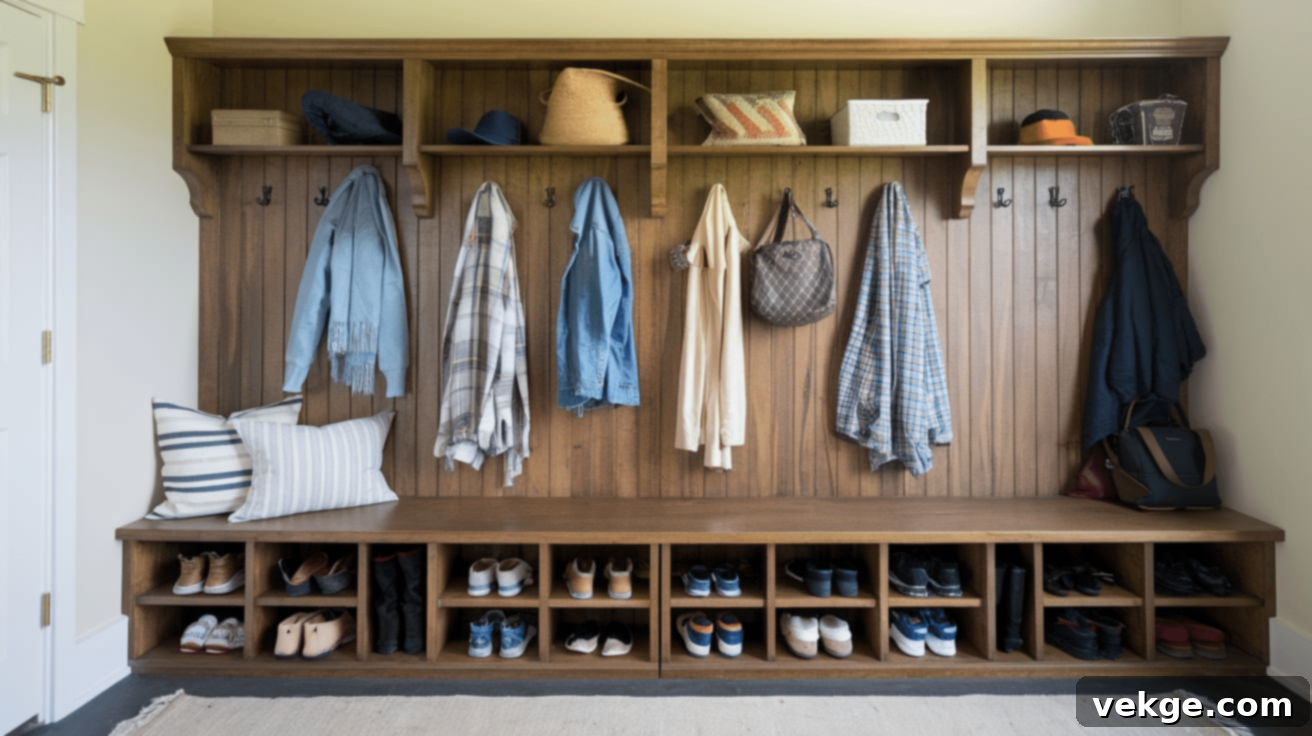
Maximize your wall space by choosing coat racks that offer more than just hooks. Look for or create units that combine coat hooks with additional storage, such as an integrated shelf above or small cubbies below. These types of coat racks with built-in shelves or storage compartments allow you to keep all your entryway essentials—coats, hats, keys, and bags—neatly consolidated in one efficient spot. This is especially helpful for busy families with a variety of outdoor gear that needs to be easily accessible yet organized.
10. Mudroom Walls with Chalkboard Paint
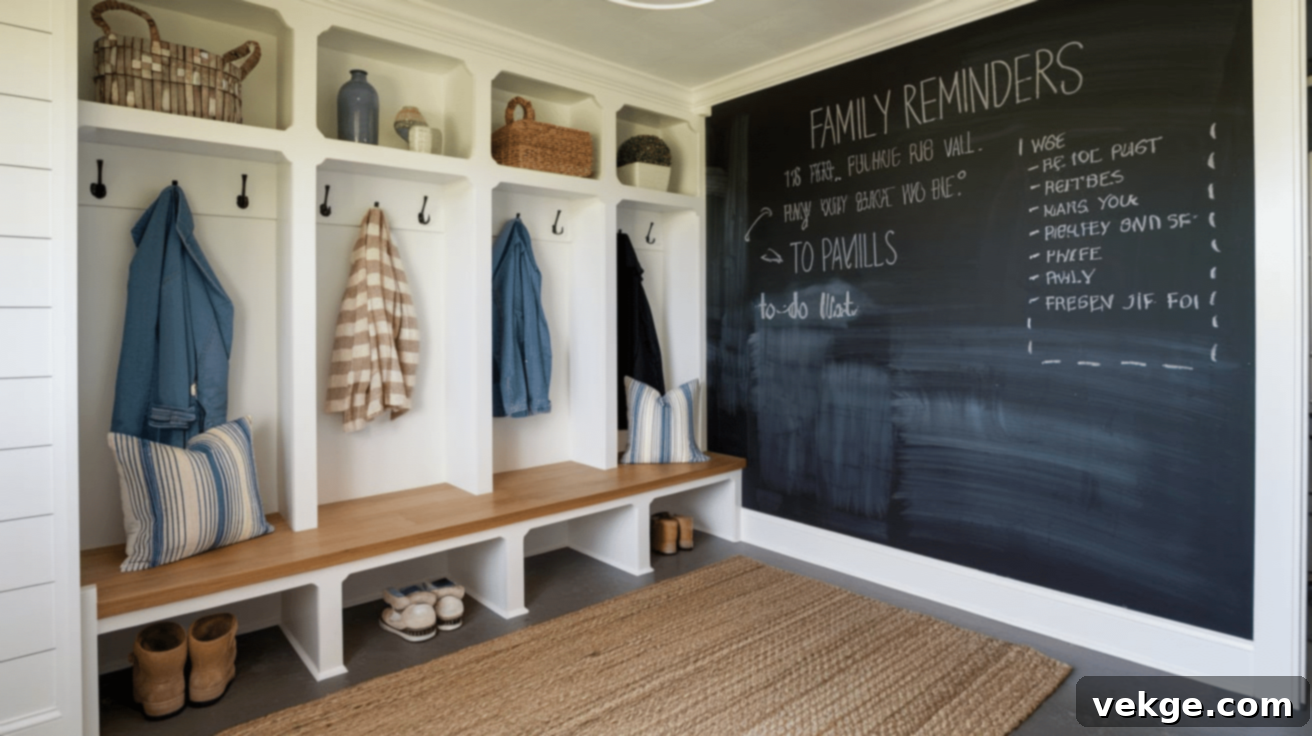
Adding a chalkboard wall or a designated chalkboard section in your mudroom is a fantastically fun and functional idea. It provides a dynamic space for writing family reminders, grocery lists, important to-do lists, or even leaving inspirational messages. This playful yet practical element adds a unique touch of farmhouse charm and helps keep everyone on the same page. Chalkboard paint is surprisingly easy to apply to any smooth wall surface, making it an accessible and budget-friendly DIY project.
11. Repurpose Old Furniture
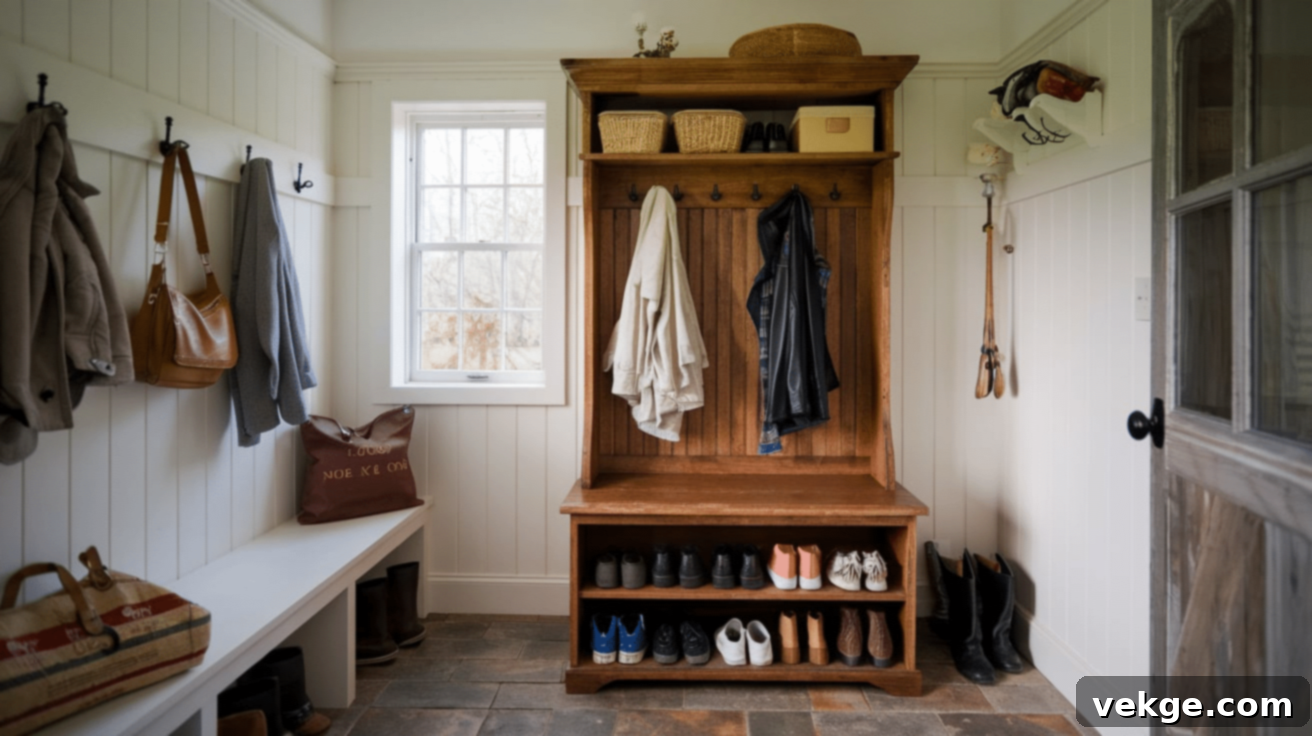
Achieving a charming farmhouse mudroom doesn’t mean you need to invest in brand new furniture. Take a creative approach by looking around your home, or at local thrift stores and salvage yards, for old cabinets, side tables, dressers, or even vintage lockers that can be repurposed for storage. A fresh coat of paint in a neutral farmhouse hue, some new vintage-style hardware, or a simple refinishing job can transform these old pieces into unique, character-filled, and highly functional furniture for your mudroom, often at a fraction of the cost of new items.
12. DIY Shelves
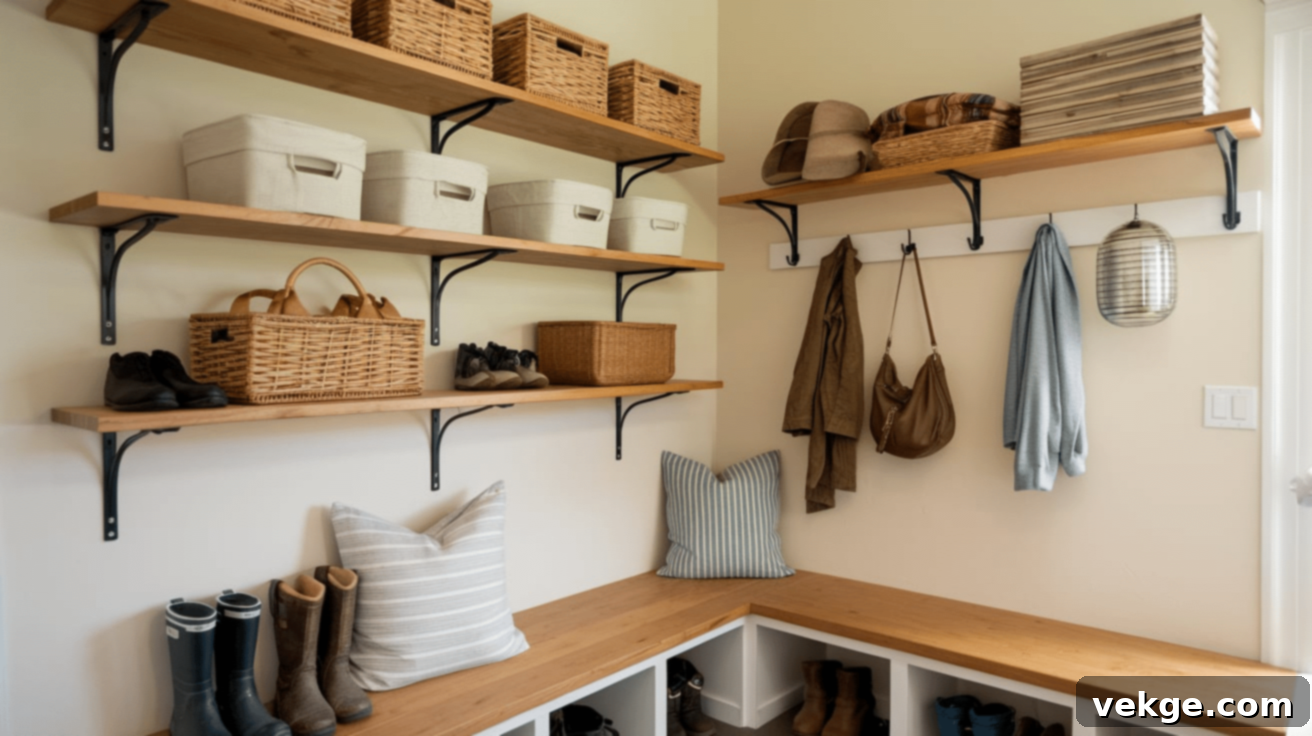
Building your own shelves is an incredibly budget-friendly and satisfying way to add customized storage to your mudroom. With some basic lumber, a few simple tools, and a weekend, you can create custom shelves that perfectly fit the dimensions and specific needs of your space. Painted wood planks, stained rustic timber, or even reclaimed lumber can be used to achieve that authentic farmhouse look, adding warmth and practical storage without breaking the bank. Floating shelves or sturdy brackets can be incorporated based on your style preference.
13. Simple Coat Hooks
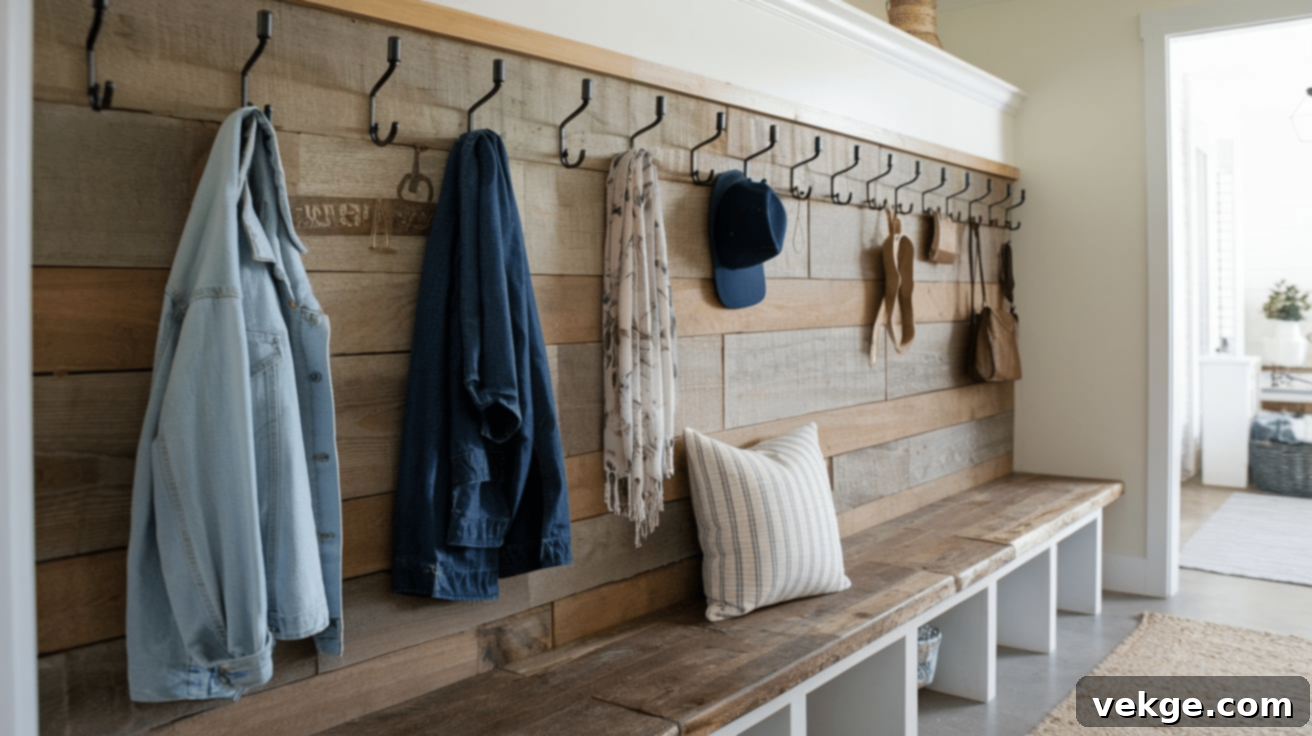
Sometimes, the simplest solutions are the most effective and affordable. Instead of investing in elaborate, expensive coat racks, consider installing a series of simple, well-placed coat hooks. You can attach individual hooks directly onto a wall, or mount them onto a salvaged wooden board to create a custom, rustic-looking coat rack. This low-cost approach is highly effective for keeping jackets, backpacks, and bags organized and easily accessible, preventing entryway clutter and maintaining the minimalist farmhouse aesthetic.
14. Utilize Baskets and Buckets
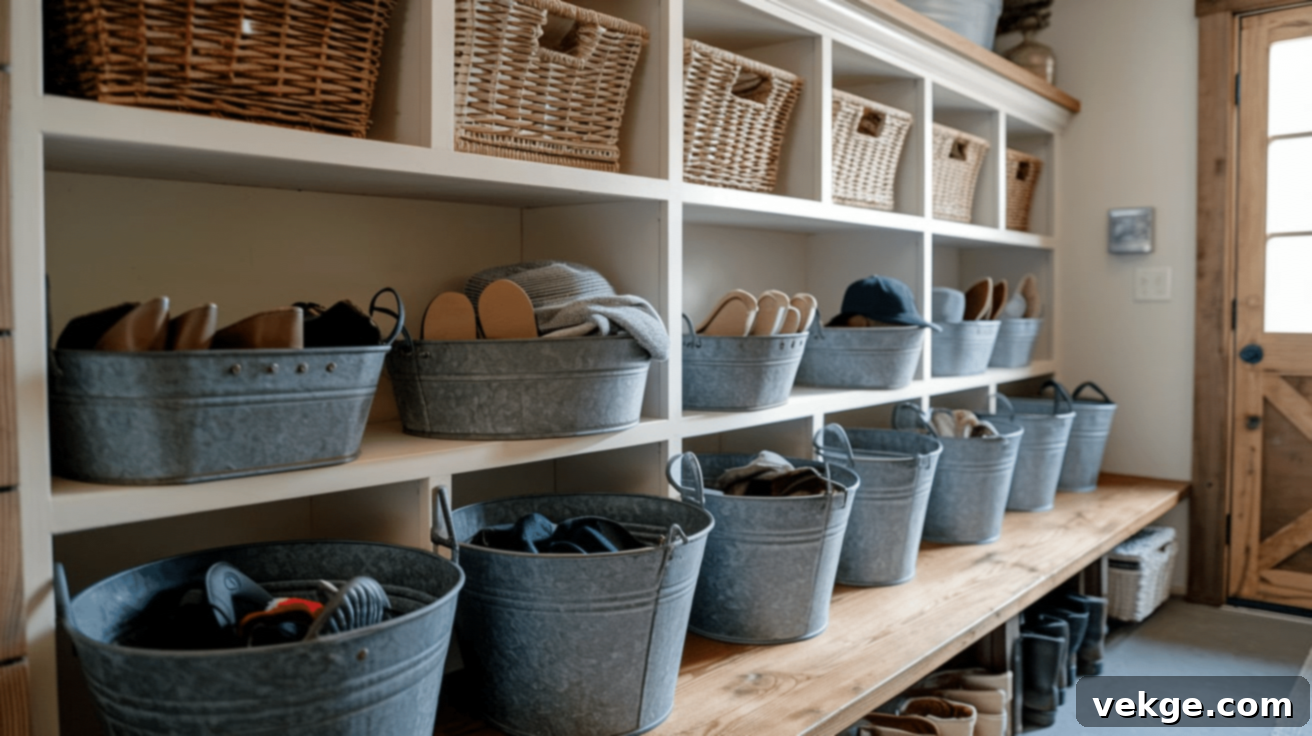
Baskets and metal buckets are charming and incredibly versatile storage solutions that are typically quite inexpensive. Use them creatively to organize shoes, scarves, hats, gloves, or even pet supplies. You can easily find an array of affordable baskets at discount stores, thrift shops, or craft stores. Opt for natural materials like wicker, woven rope, or wire baskets to maintain the farmhouse aesthetic. Galvanized metal buckets or pails can also add an industrial-farmhouse touch while offering durable storage for taller items like umbrellas.
15. Painted Pallet Bench
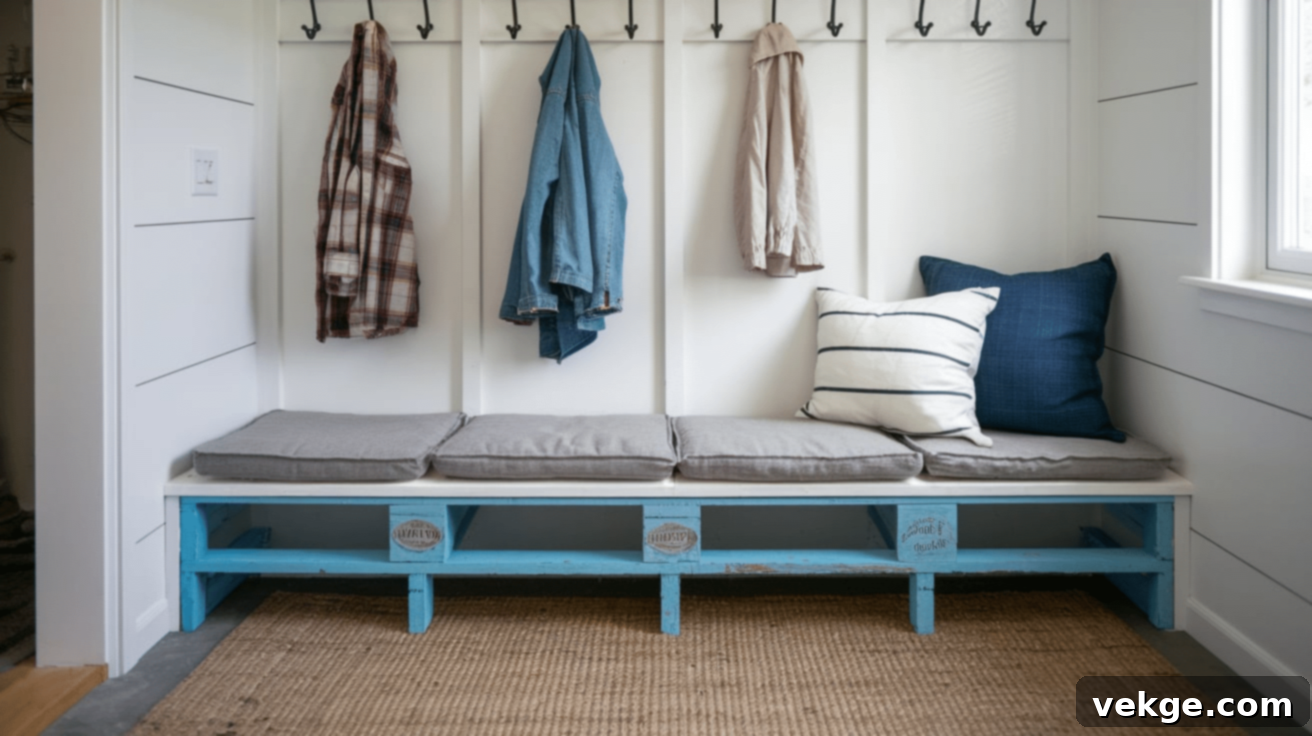
For a truly affordable and DIY-friendly seating option, consider crafting a bench from wooden pallets. Pallets are often easy to find, sometimes even for free, and can be transformed with a bit of sanding and a fresh coat of paint in a farmhouse-appropriate color. Customize your pallet bench with a soft cushion or some throw pillows for added comfort and style. This creative solution provides both stylish and functional seating for your mudroom, adding a touch of rustic ingenuity.
16. Incorporate Reclaimed Wood

If you’re aiming for an authentic, budget-friendly rustic farmhouse look, reclaimed wood is your best friend. Search for old wood planks, discarded pallets, or scrap lumber from local hardware stores, construction sites, or online marketplaces. This character-filled wood can be repurposed into mudroom shelves, a unique benchtop, a decorative accent wall, or even custom hooks. Its natural imperfections and weathered patina add a unique touch of history and warmth, making your mudroom feel instantly aged and charming without a hefty price tag.
17. Use Old Crates for Storage
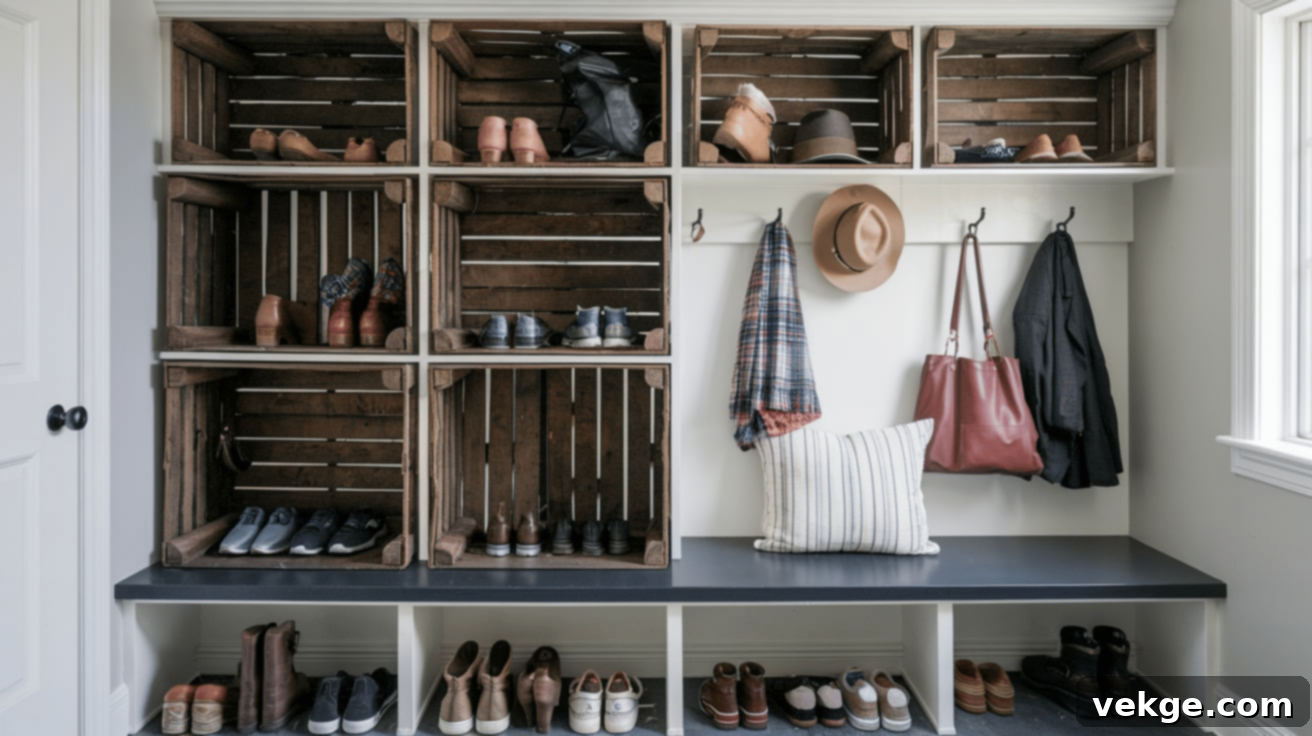
Old wooden crates offer a wonderfully cheap and creative way to introduce versatile storage into your mudroom. You can stack several crates on top of each other to create a rustic, modular shelving unit that can be easily rearranged. These charming crates are perfect for holding shoes, bags, magazines, or other outdoor gear. A quick clean, maybe a light sanding, or even a coat of paint can instantly transform them into functional and aesthetically pleasing elements that add a charming vintage look to your space.
18. Add a DIY Rug
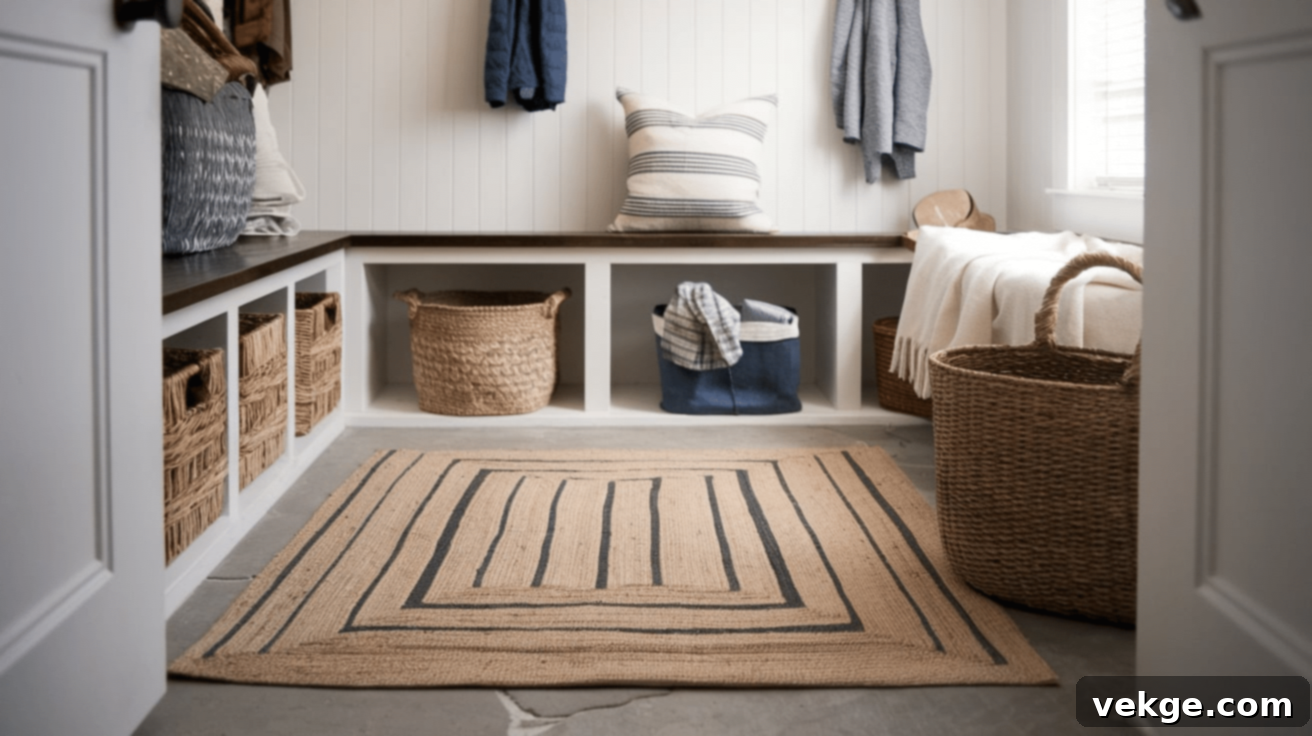
Instead of purchasing an expensive designer rug, consider making your own to add a personal and budget-friendly touch to your mudroom floor. You can use inexpensive fabric remnants, old blankets, or even braided rope to create a simple yet stylish DIY rug. This creative project not only saves money but also allows you to fully customize the rug’s size, pattern, and colors to perfectly complement your mudroom decor and individual farmhouse style, absorbing dirt and adding warmth.
19. Repurpose Old Doors
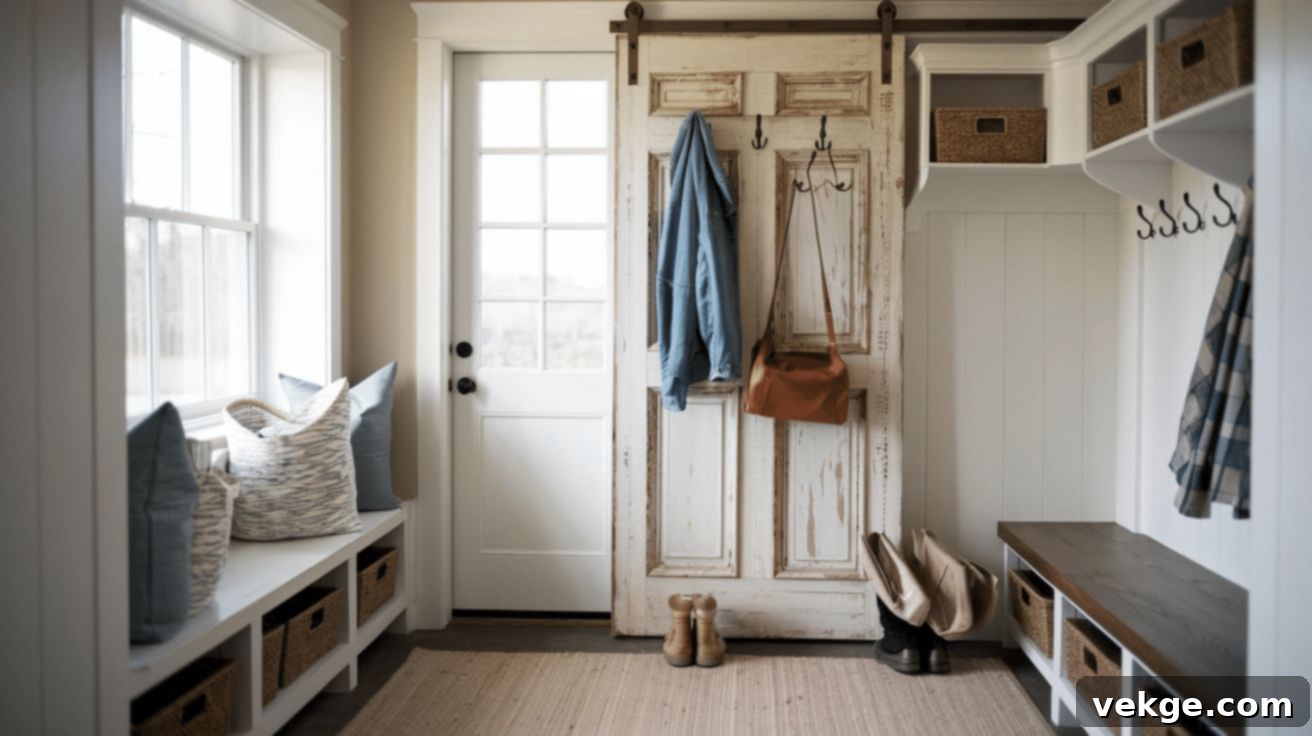
Give old, discarded doors a new life by repurposing them into unique and character-filled mudroom features. An old solid door can be transformed into a charming bench by adding legs, a decorative shelf unit, or even a striking coat rack by simply attaching hooks. Repurposed doors instantly add architectural interest, a sense of history, and undeniable character to your space, and they are often easy to find at thrift stores, architectural salvage yards, or online for very little cost.
20. Simple Wall Hooks for Hats and Scarves
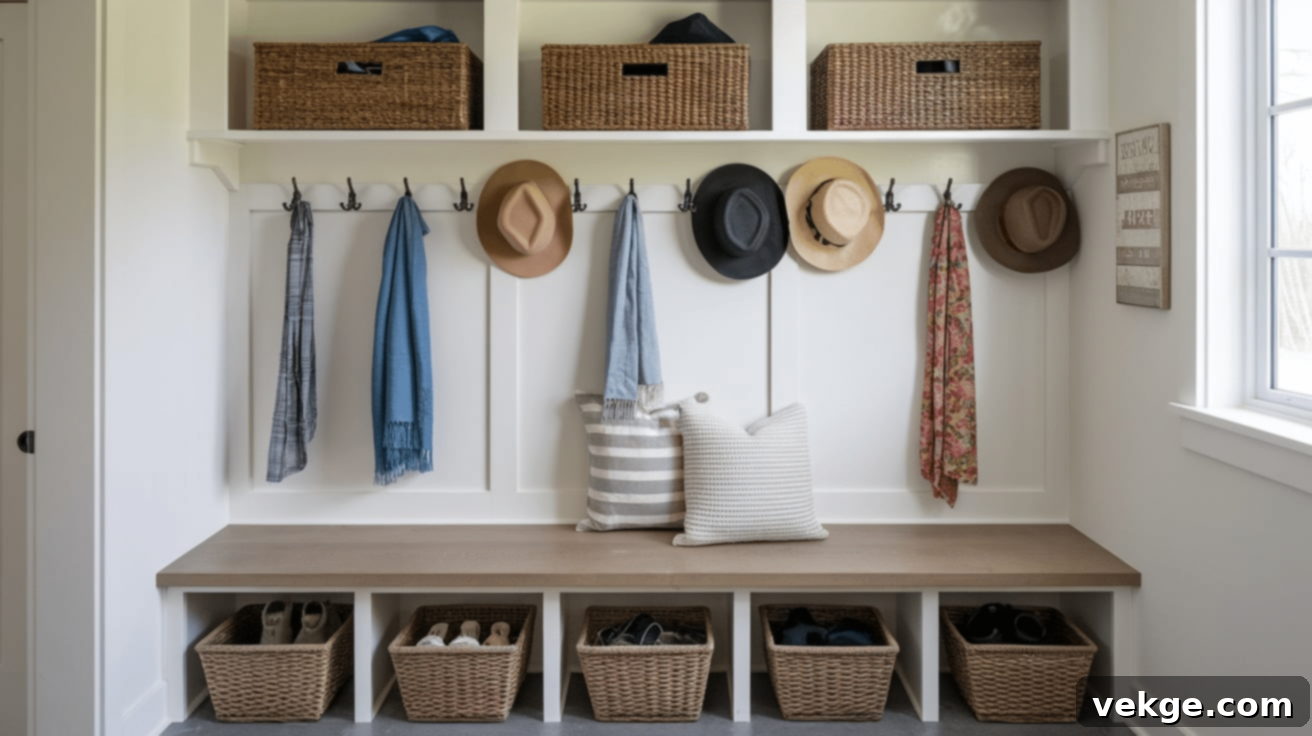
For smaller items that can easily get lost, a dedicated set of wall hooks is a simple, inexpensive, and highly effective way to keep your mudroom organized. Use them specifically for hanging hats, scarves, keyrings, or even small lightweight bags. You can find stylish hooks in various farmhouse-friendly finishes (like matte black, oil-rubbed bronze, or white ceramic) online or at home improvement stores for a reasonable price. These small additions go a long way in keeping clutter at bay and ensuring these frequently used items are always within easy reach.
Creating a farmhouse mudroom is indeed more accessible and affordable than you might initially think. By thoughtfully combining budget-friendly DIY ideas with a creative utilization of your available space, you can design a functional, charming, and highly personalized mudroom that seamlessly integrates with your home and lifestyle. Whether you’re skillfully repurposing old furniture, constructing your own custom shelves, or simply adding a few meaningful personal touches, a well-executed farmhouse mudroom will undoubtedly add significant style, organization, and practical function to your home’s entryway.
Maintaining Your Farmhouse Mudroom for Lasting Cleanliness
Keeping your mudroom clean and impeccably organized doesn’t have to be a daunting chore. With its high-traffic nature, regular and consistent maintenance goes a long way in ensuring it remains a neat, functional, and inviting space. Here are some simple, actionable tips to help you effectively maintain your farmhouse mudroom:
- 1. Regularly Clean the Floors: Mudrooms, by their very definition, are prone to quickly accumulating dirt, mud, and debris. Make it a habit to sweep or vacuum the floor frequently, ideally daily or every other day, to remove loose dirt. For a more thorough cleaning, mop the floor once a week with an appropriate cleaner for your flooring type. This routine will keep the space feeling fresh and prevent grime buildup.
- 2. Organize Shoes and Gear Daily: Encourage family members to immediately put away their shoes, coats, and bags in their designated spots upon entering. Ensure shoes are neatly stored in baskets, cubbies, or on shoe racks, and coats are hung on hooks. Regularly check the space and promptly remove any items that don’t belong or have been left out, preventing clutter from taking over.
- 3. Wipe Down Surfaces Weekly: Dust and dirt can settle on shelves, hooks, benches, and other surfaces. Dedicate a few minutes each week to wipe down all hard surfaces with a damp cloth or an all-purpose cleaner. This simple task prevents dust and grime from accumulating and keeps your mudroom looking spick and span.
- 4. Declutter Often: Schedule a quick decluttering session, perhaps once a week or bi-weekly. This involves taking a few minutes to remove any items that are no longer needed, out of season, or have simply found their way into the mudroom. This could mean tidying up old mail, putting away stray toys, or rotating seasonal gear. A streamlined mudroom is an organized mudroom.
- 5. Address Spills and Mud Immediately: As a zone for all things messy, spills and mud are inevitable. Tackle them as soon as they happen. Promptly wiping up spills or scrubbing away mud stains will prevent them from setting in and becoming harder to clean later, preserving your mudroom’s pristine condition.
By staying on top of these small, consistent tasks, your farmhouse mudroom will effortlessly remain a clean, organized, and beautiful asset to your home, truly fulfilling its purpose as a functional and stylish entryway.
Conclusion
A farmhouse mudroom is far more than just a functional space; it’s a practical and stylish addition that significantly enhances the comfort and organization of your entire home. It serves as a vital transition zone, providing a dedicated and attractive place for coats, shoes, bags, and other outdoor essentials, effectively keeping the rest of your living areas clean and clutter-free.
With the right design elements and thoughtful features, your mudroom can be both exceptionally functional and incredibly cozy, adding a unique layer of charm and character to your home’s overall aesthetic. From incorporating rustic necessities like sturdy wooden benches and woven baskets to integrating architectural details such as classic shiplap walls and space-saving sliding barn doors, there are abundant ways to create a welcoming and highly efficient mudroom tailored to your family’s needs.
Crucially, achieving the coveted farmhouse look doesn’t require an extravagant budget. Through creative DIY projects, the clever repurposing of old furniture, and smart material choices, you can design a beautiful and functional mudroom without breaking the bank. A well-designed and thoughtfully organized mudroom truly is a game-changer for any home, making daily routines smoother and life a little more streamlined. Creating a space that perfectly works for you and your family is not only achievable but also an incredibly rewarding home improvement project!
Frequently Asked Questions
Can I create a mudroom in a small space?
Absolutely! You can create a highly functional mudroom even in the smallest of spaces. The key is to utilize vertical space and choose multi-functional elements. Consider installing wall-mounted hooks and floating shelves to maximize storage without taking up floor space. A compact, narrow bench or even just a designated stool can provide seating. Small, stackable baskets or bins are also excellent for organizing smaller items in tight quarters. Every little bit of dedicated organization makes a difference.
What are the best flooring options for a mudroom?
Given the mudroom’s purpose, the best flooring options are those that are durable, water-resistant, and easy to clean. Excellent choices include porcelain or ceramic tile, which are highly resilient and handle moisture exceptionally well. Vinyl plank flooring is another fantastic option, offering great water resistance, durability, and a comfortable feel underfoot, often mimicking the look of wood or stone. Hardwood with a protective seal can also work, but tile or vinyl generally offer superior performance against wet or muddy shoes and spills.
How can I create a budget-friendly farmhouse mudroom?
Creating a stylish farmhouse mudroom on a budget is entirely achievable with smart choices and DIY effort. Start by repurposing old furniture, such as dressers converted into storage benches or cabinets used for cubbies. Utilize inexpensive baskets and buckets for practical and attractive storage. Embrace DIY projects like building your own shelves from reclaimed wood, painting old crates, or installing simple coat hooks. Thrift store finds, a fresh coat of paint, and creative use of materials like pallets or old doors can dramatically transform your space without significant expense.
How do I keep my mudroom organized and clean?
Maintaining an organized and clean mudroom relies on consistent habits and effective storage solutions. Implement a system using baskets, bins, cubbies, or shelves to give every item—shoes, coats, bags, hats, and scarves—a designated home. Label baskets if necessary, especially for family members. Encourage everyone to put items away immediately upon entering. Regularly sweep or vacuum floors, wipe down surfaces, and perform quick decluttering sessions weekly. Addressing mud and spills promptly will prevent them from becoming larger issues.
What colors work best for a farmhouse mudroom?
Farmhouse style typically embraces a neutral and earthy color palette to create a serene and timeless atmosphere. Classic choices include crisp whites, soft creams, warm grays, and muted beige tones. These colors not only brighten the space, especially if natural light is limited, but also provide a versatile backdrop for natural wood accents and rustic decor. Soft blues, greens, or even a subtle charcoal gray can be introduced as accent colors on a feature wall or through accessories to add depth and personality while maintaining the farmhouse aesthetic.
